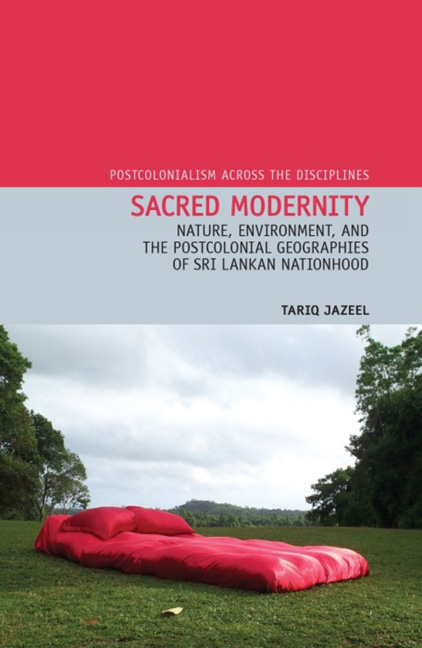Book contents
- Frontmatter
- Dedication
- Contents
- List of Map and Figures
- Acknowledgements
- Introduction
- 1 Sacred Modernity: Nature, Religion, and the Politics of Aesthetics
- Part I Ruhuna (Yala) National Park
- Part II Tropical Modern Architecture
- 5 Built Space, Environment, Modernism: (Re)reading ‘Tropical Modern’ Architecture
- 6 Architecting One-ness: Fluid Spaces/Sacred Modernity
- 7 Over-determinations: Architecture, Text, Politics
- Conclusion: Sri Lankan Nature as Problem Space
- Bibliography
- Index
6 - Architecting One-ness: Fluid Spaces/Sacred Modernity
from Part II - Tropical Modern Architecture
- Frontmatter
- Dedication
- Contents
- List of Map and Figures
- Acknowledgements
- Introduction
- 1 Sacred Modernity: Nature, Religion, and the Politics of Aesthetics
- Part I Ruhuna (Yala) National Park
- Part II Tropical Modern Architecture
- 5 Built Space, Environment, Modernism: (Re)reading ‘Tropical Modern’ Architecture
- 6 Architecting One-ness: Fluid Spaces/Sacred Modernity
- 7 Over-determinations: Architecture, Text, Politics
- Conclusion: Sri Lankan Nature as Problem Space
- Bibliography
- Index
Summary
Reading the politics of nature from Sri Lanka's tropical modern architecture is not just a question of situating the effort and inscriptions of its authors. It also requires considerable work to tease out the built space's semiotic materialisms; that is, the combination of the building techniques that characterize the style, and, importantly, the common structural and narrative qualities of the environmental experiences those building techniques afford users. The task of this chapter then is to delineate the entwinedness of tropical modern style with dominant structures of feeling and being. By considering the work of architecture, and how architecture works, the chapter traces the relationships between ‘doing, making, being, seeing and saying’ (Rancière 2004: 45). In the context of Sri Lanka's ethnicized politics of difference, it excavates the social and political contours of tropical modern built space as it is physically and imaginatively inhabited.
In this respect, there are three movements to this chapter. First, I sketch a range of common building techniques and ideologies developed by tropical modern architects over the last half century. Second, drawing predominantly on interview material, I describe the environmental aesthetics that such techniques afford users of (predominantly domestic) tropical modern built space. And, finally, I tease out a dominant cultural logic of these aesthetic domains that, I argue, continues to instantiate an ethnicized spatial politics of everyday life.
Building Tropical Modern Space: Techniques, Materials, and Tropicality
Though each of Sri Lanka's tropical modern architects has their own design signature, there are certain common techniques for building space that can be identified across tropical modernism's variety. It is perhaps fair to say that these technical commonalities are what draw together a range of disparate structures as something like tropical modern architectural ‘style’. One defining ideological characteristic of tropical modernism emerges from that self-consciously ‘post-colonial’ effort to mark an appropriate rupture from colonial building techniques and this has been manifested in a challenge to open out the colonial house. Central within this ongoing ideological effort, however, has been a set of more material techniques and challenges that in different ways has driven modern architects to develop something like a tropical modern style of building. These are a concern for vernacularizing materials, as well as temporalizing objects, and due attention to climatic and physical tropicality, as well as the necessity to confront the environmental relationships between structure and site.
- Type
- Chapter
- Information
- Sacred ModernityNature, Environment and the Postcolonial Geographies of Sri Lankan Nationhood, pp. 121 - 144Publisher: Liverpool University PressPrint publication year: 2013



